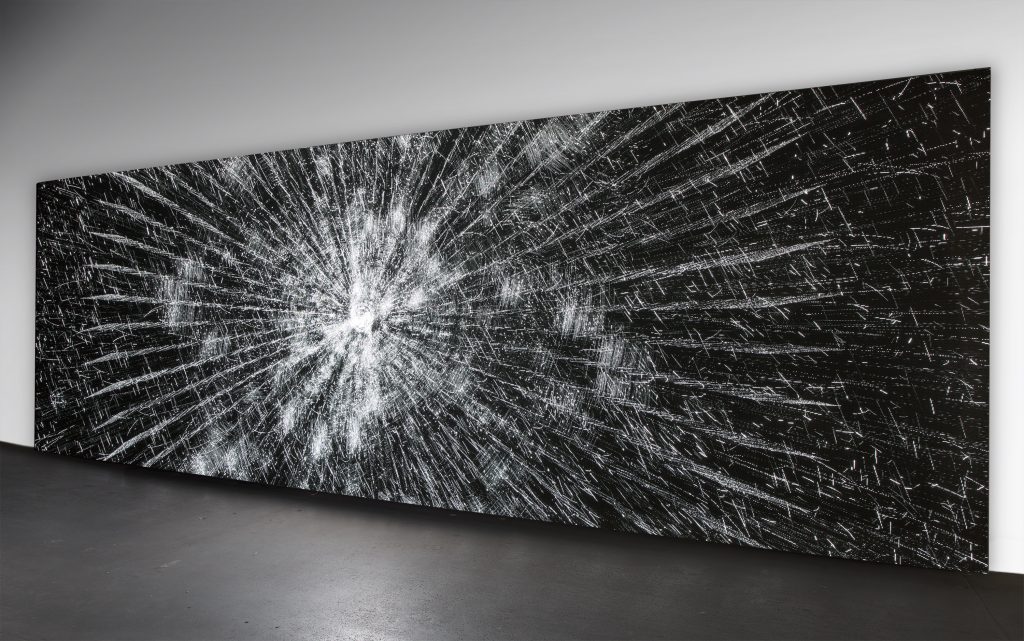
London—Pace Gallery is to present the first solo-exhibition of works by American artist Leo Villareal at Pace in London. The exhibition will be on view at 6 Burlington Gardens from 22 November 2019 to 18 January 2020, and coincides with the recent launch of Villareal’s Illuminated River—a major public artwork that, upon completion, will illuminate 14 bridges along the Thames. Launched in July 2019, four bridges – London, Cannon Street, Southwark and Millennium – are now lit up in unison with sequenced LED patterns subtly unfolding across each unique structure.
Firmly rooted in abstraction, Villareal’s works utilize LED lights and custom software to translate the layered and sequential logic of systems into beguiling visual experiences. The works in the exhibition exist at the vanguard of digital technology while drawing on a history of practices engaged with mass imagery, mechanical reproduction, and the materiality of light. For his exhibition at Pace, Villareal expands these legacies across a body of new and recent work, which include three new LED works of varying scales alongside six single-panel pieces from the Instance series (2018), as well as Corona (2018), a triptych of OLED screens. The works expand upon the artist’s fascination with visualizing systems—both their operation and disruption—through the phenomenal properties of light.
At the centre of the exhibition is Detector (2019), a monumental work that spans over ten metres and features undulating fields of patterned luminescence, suggesting the sifting of stars, galaxies, and other astral phenomena. Signals penetrate through fields of noise as clusters of particles expand and collide, conjuring antipodal forms from the cosmic to the atomic. Two works flank Detector—titled Optical Machine I & II—and serve as portals into the visual manifestation of Villareal’s rule-based software, which engages chance through the concepts and computational techniques of artificial life and emergent behaviour. Employing a highly synthetic process, Villareal’s works nevertheless echo the ubiquitous systems that produce organic behaviours found throughout nature.
The six pieces from Villareal’s Instance series function both as individual artworks and as part of an orchestrated whole. For the exhibition, the artist has networked together two groups of three works from the series, allowing the individual panels to act alone while at times performing in synchronicity with interconnected works. Existing simultaneously as both standalone objects and nodes in a larger system, the works convey the interdependence between their digital and physical forms while incorporating new levels of complexity in their visual behaviour. Linked together, they produce malleable synchronies wherein the possibility of order, however fleeting and subtle, flashes briefly into existence before gradually dissipating into a state of entropy.
Corona is composed of three 4K OLED screens that display animated particles rhythmically pulsing in radial choreographies. Villareal’s use of the triptych underscores the importance of art-historical precedent in his work, alluding to a format originally associated with Renaissance altarpieces, but which recurs throughout the history of painting. Corona explores how the traditional form of the triptych takes on new meaning in contemporary digital age, in which screens proliferate around us in increasingly immersive configurations. The swiftly moving particles of Villareal’s work inspire a more embodied mode of contemplation, opening outward toward the sublime vastness of the universe, the enigmatic world of subatomic particles, and the fundamental properties of living systems.
The range of Villareal’s formats spans the possibilities of current technology. The high-resolution OLED screen arrayin Corona contains 24,883,200 pixels, whereas the LED panel works feature a drastically reduced pixel pitch. By embracing a technology with reduced visual complexity, Villareal emphasizes the actual binary unit of each light-emitting diode, rooting the works in the materiality of mechanical reproduction and the discrete visual marks that comprise the substrate of printmaking. The pixelation of Villareal’s LED works finds antecedent in sources as varied as Gustave Doré’s etchings after Dante’s Inferno and the paintings of Roy Lichtenstein, whose Explosion series directly informs the artist’s pulsating nebulas of artificial light.
Leo Villareal Nov 22, 2019 – Jan 18, 2020 6 Burlington Gardens London Opening Reception: Thursday, Nov 21
6–8 PM pacegallery.com





